Modern Recognition Programs to Boost Employee Engagement and Retention
Workplaces are evolving at a rapid pace and things revolving around them need readjustments. And when it comes to employee recognition, the traditional one-size-fits-all approach has become outdated. Modern workforces are diverse, dynamic, and digitally sound. This calls for recognition programs to be equally adaptable and technology driven. Hence, the need for modern employee recognition programs has become significantly important.
In this blog, we will explore the transformative power of such programs which can enhance your company culture. Let’s dive in!
The Shortcomings of Traditional Recognition Programs
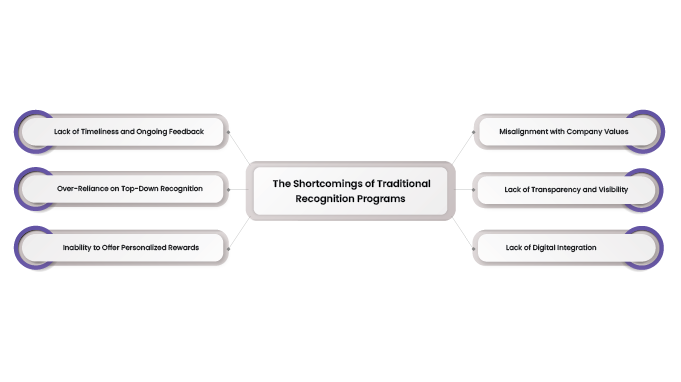
The traditional recognition programs often consist of annual performance reviews and standard rewards. With an approach like that, it has become unable to meet the varied needs of the modern workforce. The primary reasons for this include:
1. Lack of Timeliness and Ongoing Feedback
The annual or quarterly recognition cycles take up a huge amount of time. And with the workforce mostly consisting of Millennials and Gen-Z, things need to be on the go. They desire instant feedback and recognition which is not possible with the traditional approach. In the long run, it becomes difficult to integrate into the system which can hamper daily operations and motivation.
2. Over-Reliance on Top-Down Recognition
Managers might miss out on providing recognition, which can have a negative impact on the employees. Top-down recognition is mostly prevalent with traditional recognition programs. It does not provide the opportunity of peer recognition which employees want. Moreover, it also does not provide any sort of flexibility or the little nuances of recognition which can be daunting in modern times.
3. Inability to Offer Personalized Rewards
The biggest problem with traditional programs is that they are not customizable. Employees have diverse preferences and needs. The focus now is tailoring the recognition program that will align with the modern workforce. However, traditional programs lack that and do not have the provision to make adjustment. In the long run, this can pose a major roadblock towards motivating the workforce.
4. Misalignment with Company Values
Organizations often recognize some abstract "model employee" rather than those exemplifying core values. Defining behavior metrics around company principles provides actionable direction on which accomplishments to praise. This alignment propels the organization unitedly forward. And this is something difficult to achieve with recognition programs not up to date.
5. Lack of Transparency and Visibility
Traditional programs often recognize employees behind closed doors, keeping accomplishments invisible. And with the modern workforce, social gratification is something they desire. Moreover, social recognition feeds increase transparency, allowing organizations to collectively celebrate successes. Public praise builds camaraderie and connectivity. These are the things traditional programs lack in the long run, hampering the employees' overall morale.
6. Lack of Digital Integration
In a world where digital interaction is everywhere, traditional recognition methods fail to leverage digital platforms. This makes a workplace seem outdated and inaccessible, limiting their reach and impact. Hence, this hinders the automation of recognition processes and minimizes the flexibility of organizations.
The Advantages of Modern Employee Recognition Programs
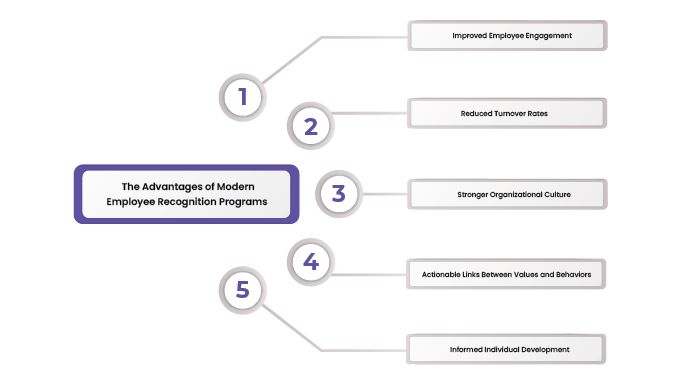
Modern recognition programs, designed with today's diverse and digital-first workforce in mind, offer numerous advantages:
1. Improved Employee Engagement
Regular and instant recognition aligns behaviors to goals and boosts morale. It also makes employees feel valued, which is a key driver of engagement. The biggest advantage is that it is embedded within day-to-day operations. In the long run, it overcomes the drawbacks of annual reviews or traditional recognition programs
2. Reduced Turnover Rates
When employees feel appreciated in time, it compels them to stay with the organization. It demonstrates that they are valued and the organization cares. Moreover, modern programs also empower peers with the ability to acknowledge their colleagues. This gives them a sense of authority and the program becomes authentic with genuine recognition.
Read more: What Is Employee Turnover And How To Calculate It
3. Stronger Organizational Culture
Public recognition with the help of virtual platforms increases transparency. This allows organizations to collectively celebrate achievements. Public recognition also inspires others to do well as they see their coworkers praised firsthand. It builds healthy competition and productivity, which is beneficial for the organizational bottom-line. In the long run, it fosters a culture of appreciation while significantly improving the overall culture.
4. Actionable Links Between Values and Behaviors
Modern programs define detailed recognition criteria based on company values. This ensures that employees have clarity on what is needed of them. It channels their behaviors and how they can replicate them that will align with the end goals. As for the leaders, they can track these values and link it with the employee behavior. They can check if the employees are adapting to them and where the grey areas are. A deep dive will help the organization to reward and recognize the employees who did well and made the most out of it.
5. Informed Individual Development
Advanced analytics provide insight into employee strengths and growth areas based on recognition patterns. The current programs are powered by AI that makes personalized reward recommendations. Leaders can then tailor coaching, training, and advancement opportunities. This caters to the skill development of individuals based on the insights and helps in properly schedule a plan of growth.
Essential Features of Modern Recognition Programs
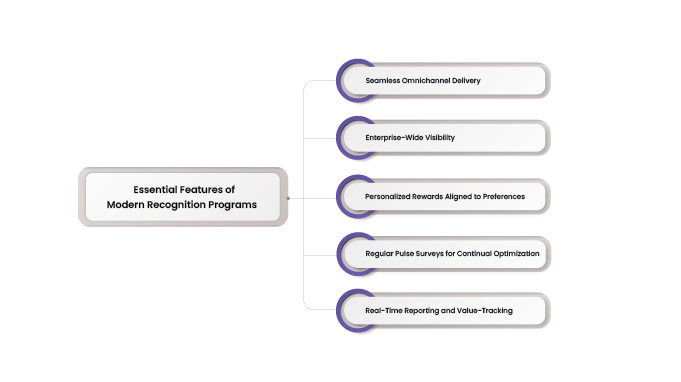
To effectively engage and retain employees, modern recognition programs incorporate several key features:
1. Seamless Omnichannel Delivery
Contemporary programs integrate recognition seamlessly across multiple platforms, maximizing adoption and participation. Employees can nominate via desktop or mobile platforms, while recipients get alerts through popular communication channels. This enhances the engagement and experience of the users, encouraging them to use it regularly.
2. Enterprise-Wide Visibility
Advanced programs have numerous features and one of them is the virtual feed section. This enables employees to see peer accomplishments regardless of department. It is transparent and fosters company-wide connectivity. Employees can engage by commenting and liking the feed post and acknowledge their colleagues. This work as a good confidence and morale booster.
3. Personalized Rewards Aligned to Preferences
AI algorithms analyze past reward selections, employee metadata like hobbies, and program analytics to recommend tailored options. Rather than one-size fits all, modern recognitions match distinct interests like learning, wellness, charity, experiences, or financial gifts.
4. Regular Pulse Surveys for Continual Optimization
Effective modern programs regularly survey users to understand what they want from the program. It can be addition of features, rewards ideas, platform usability, motivational impact and varied key metrics. This flexible feedback loop allows readjustments in the program to make it more relevant and impactful.
Learn More: Everything about Employee Pulse Survey in 2024
5. Real-Time Reporting and Value-Tracking
Robust analytics of modern programs allow the leaders to track the program ROI. It also gives a clear picture of adoption across segments, identifies top recognizers and spotlight trends. This helps in optimizing the engagement drivers as per requirement so leaders can take strategic improvements in the long run.
Emerging Trends in Modern Recognition Programs
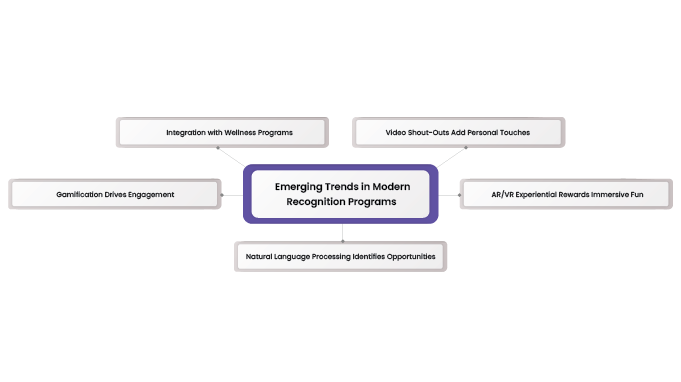
The landscape of employee recognition is continually evolving, with new trends reflecting the changing needs and preferences of the workforce:
1. Integration with Wellness Programs
Leading companies integrate recognition and wellness, enabling programs to reward physical, emotional, financial and social well-being. This holistic view fuels a motivated, happy and productive workforce. Example rewards include extra vacation, self-care subscriptions, or donations to charity.
2. Gamification Drives Engagement
Gamified programs tap into people’s intrinsic desire for status, competition and achievement. Elements like points, levels, challenges, virtual badges and leaderboards motivate participation. Employees feel invested in recognition-based "journeys".
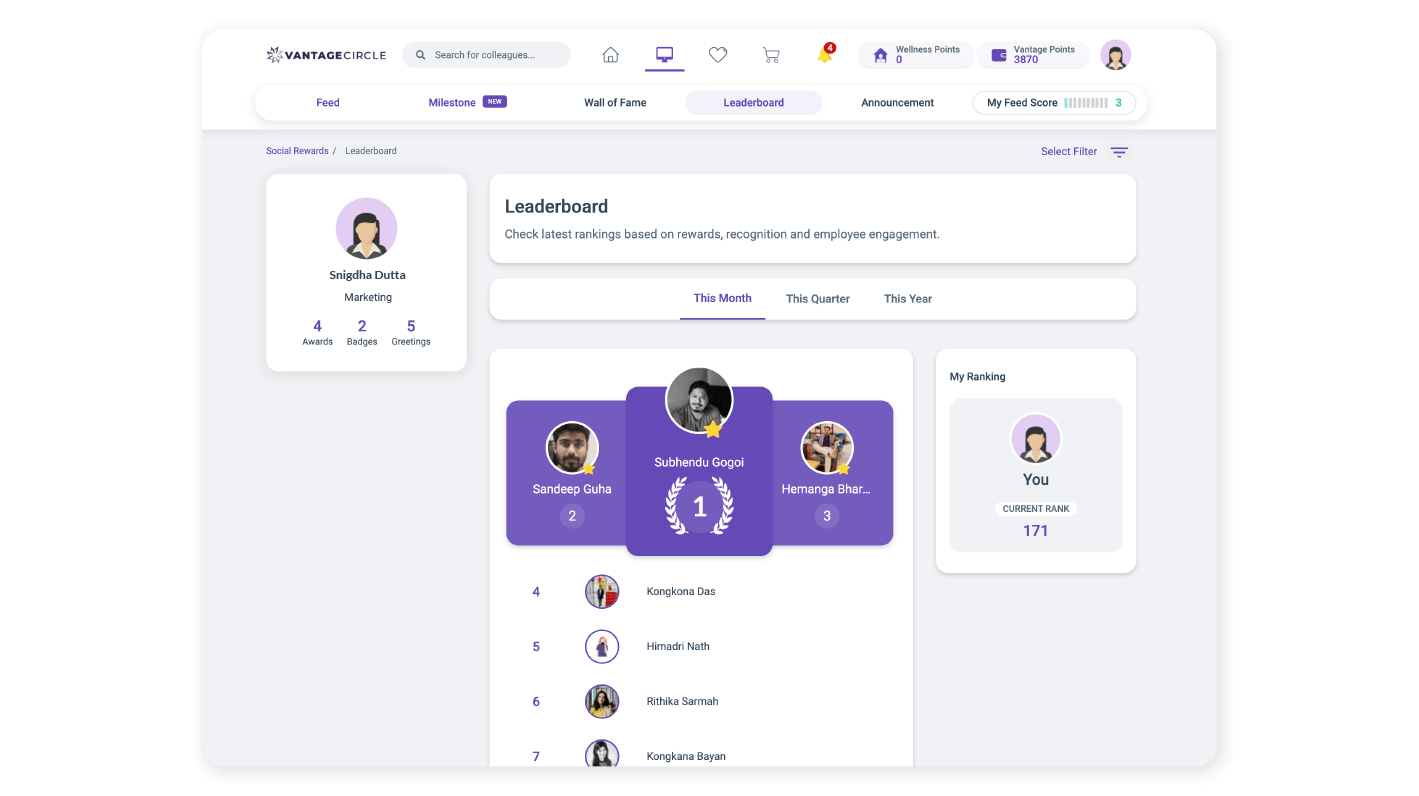
(Source: Vantage Circle)
3. Natural Language Processing Identifies Opportunities
AI now automatically analyzes workplace communication channels to detect good work that may otherwise go unrecognized. The technology can determine positive sentiment, context, and entities within messages to prompt relevant recognition.
4. Video Shout-Outs Add Personal Touches
Employees increasingly prefer asynchronous video messages to celebrate accomplishments over traditional written recognitions alone. The human voice and facial expressions add more authenticity, connection and emotion to the experience.
5. AR/VR Experiential Rewards Immersive Fun
Some innovative companies now offer augmented and virtual reality redeemable rewards putting employees at the center immersive, gamified 3D experiences ranging from global travel adventures to interactive game shows. These highly memorable recognitions boost employee delight.
Implementing a Successful Modern Recognition Program
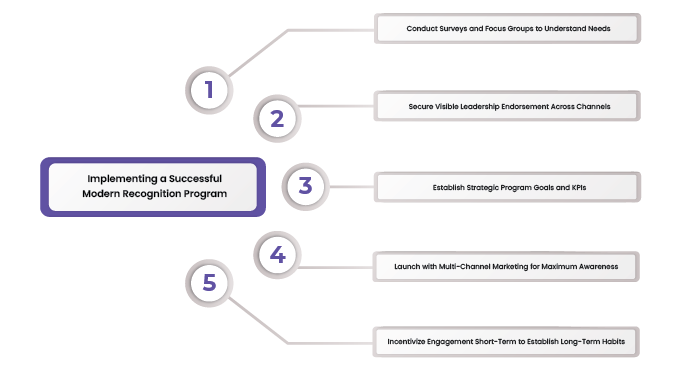
Developing an effective modern recognition program involves strategic planning and execution:
1. Conduct Surveys and Focus Groups to Understand Needs
Prior to program design, survey employees at all levels and hold focus groups and interviews to gather input. It can include things like desired features, preferred reward types, platform usability, motivators for participation and more. Emphasize anonymity in surveys to surface honest opinions and ideas. This early involvement gets employees invested.

(Source: Vantage Pulse)
2. Secure Visible Leadership Endorsement Across Channels
Ensure executive leaders and front-line managers actively champion the new recognition program. It can be done through their words and behavior across all communication channels - email, video, events, etc. Employees look to management’s example when adopting workplace initiatives. Ongoing visible support from the top-down assures broad engagement.
3. Establish Strategic Program Goals and KPIs
Set specific program goals like-
-
Boosting engagement scores
-
Increasing cross-departmental collaboration
-
Reinforcing growth mindsets and
-
Reducing turnover rates.
Tie goals directly to overarching organizational objectives. This will help leaders quantify impact through key performance indicators and make the business case for investment.
4. Launch with Multi-Channel Marketing for Maximum Awareness
Raise company-wide awareness at launch through email campaigns. The campaigns can showcase-
-
Peer stories
-
Prominent features
-
Posters branding high-traffic areas
-
Pledges from executives publicly committing to participate
-
Points-based participation contests...and more.
Creative kickoffs create an environment of excitement that gathers the interest of employees. Once employees invest their time, they are eager to try it out. This prompts early participation and peer advocacy which can drive success for the program.
5. Incentivize Engagement Short-Term to Establish Long-Term Habits
Initially boost participation by incentivizing peer recognition through-
-
Temporary rewards
-
Points-based status levels
-
Competitive leaderboards celebrating top recognizers, and more.
As habitual usage forms, taper external incentives over time while sustaining engagement through program quality. This establishes durable recognition habits and increases program engagement.
Conclusion
Investing in a modern recognition program is essential for fostering a motivated, engaged, and loyal workforce. By moving beyond traditional approaches and embracing the possibilities offered by personalization, technology, and current trends, organizations can create a culture of appreciation that resonates with today's dynamic workforce. The benefits of such an investment are clear: enhanced employee engagement, improved retention rates, and a positive, collaborative company culture that drives success.

















